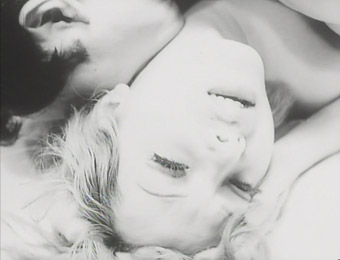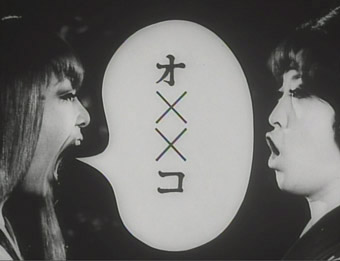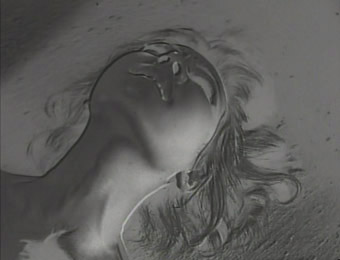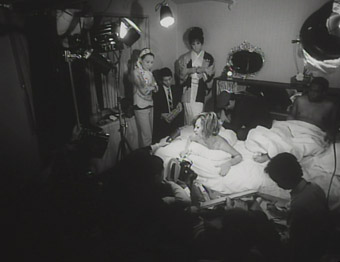|
The
term 'postmodernist' is thrown about quite a bit these days.
It's hardly surprising – the sometimes tiresomely self-aware
nature of so much recent western TV and film material seems
to be deliberately targeted at an audience who communicate in
part by referencing popular culture, some of which – Buffy,
The Simpsons, Spaced,
etc. – is already steeped in pop cultural quotation. The
self-referential nature of postmodernist cinema can extend
to the very structure of the film itself, from a seeming
awareness of the characters that they are in a film – as
in Wes Craven's Scream series – to a complete
disregard for the idea of keeping the filmmaking process
hidden. At its most drastic, that substructure will
intrude into the narrative, most recently exemplified
by Michael Winterbottom's A Cock and Bull Story (in which the original novel is amusingly described as "Postmodernist
before there was any modernism to be post about"),
where the historical drama eventually gives way to the background
story of its production, which itself includes an interview
being conducted for inclusion as a special feature on the eventual DVD release
(it was, too).

Although
generally regarded as a relatively recent phenomenon, this
practice of cinematic self-deconstruction was small-scale
popular back in the 1960s, where it had less to do with
targeting the short attention span audience, being more an
expression of the influence of the avant garde and hallucinogenic
drugs on a new breed of young filmmakers looking to shake off the traditionalist
styles of their industry predecessors and break new artistic
ground within the feature format. This was a time of radical
change, of protest and experimentation in all walks of life
and art, so why not cinema or even television? Often regarded
as just a fun TV show built around a manufactured pop group,
the cheerfully freewheeling and mildly anarchic style of
The Monkees, for example, regularly included
elements that would today be instantly identified as postmodernist.
The concept was taken a few leaps further with its
1968 big screen incarnation, Head, when writer
Jack Nicholson (yes, that one) and director Bob Rafelson
threw artistic caution to the wind by fragmenting the narrative,
employing graphics and editing techniques that drew attention
to the filmmaking process, visually and aurally referencing
a number of external media sources, and working in a critique
of the very show and characters that they were presumably
employed to celebrate. At one point, the film even stops
when one of the cast is unhappy with his dialogue and the
entire crew enters the shot to reset the scene and discuss
how to proceed.
This
sort of experimentation was by no means confined to western
cinema. The very nature of experimental film as an outsider
art form created a bond between its practitioners of all
nations, each aware of the work of the other and inevitably
influenced by them, and in the late 1960s the influence
of the avant garde was starting to spill over into independent
feature production. In Japan in 1969, you'll find no more
striking example of this than Matsumoto Toshio's Bara
no sōrestsu, or Funeral Parade of
Roses.
Everything
about the film seems to kick against established values,
whether they be those of mainstream cinema or society at large,
and to a degree that a staunchly traditionalist audience
would still be outraged by even today. For a start, most of the
lead characters are gay, and not quietly in-the-closet gay
but flamboyantly and cheerfully so, and transvestites to boot.
Most are played by gay men rather than trained actors (hooray!)
and are portrayed as feminine rather than effeminate. The
central character of Eddie, as played by the enigmatically
named Peter (no surname), is so strikingly convincing that
there are times when she – I use the feminine here deliberately
and respectfully – really does look beautiful, and I'm talking
from a (hopefully progressive) heterosexual male viewpoint. By this point, we should already have lost the self-proclaimed
moral majority, but it doesn't end here. The story at the
film's heart is a take on Oedipus Rex, Sophocles'
everyday tale of patricide and incest, but with a twist
here that is just guaranteed to offend the prudish. Oh yes,
there are also some erotically charged gay sex scenes, a
rejection of the traditional values of society, and an ending
whose violence is so shocking I actually yelped out loud.
Oh, it's great stuff.

On
the surface, this is a tale of personal rivalry between Leda,
the mama-san (the madam, if you will) of a Shinjuku gay
bar, and Eddie, the most attractive of the bar's hostesses,
both of whom are doting on drug dealer and bar regular Gonda.
Their rivalry (and the film's break with cinematic traditions)
is signaled early on as Leda looks in a mirror and the phrase
"Mirror, mirror on wall, who is the fairest of them
all?" pops up as a non-diegetic graphic, only to have
Eddie appear behind her at that very moment. This love triangle
plays almost as background detail to the everyday
lives of Eddie and his friends, as they party, take drugs,
make out, go shopping and work the customers in the Bar
Genet. In another pleasing kick against expectations, the
bar's patrons are a thoroughly manly bunch and not remotely
effeminate, none more so than Gonda (emphasised perhaps
by the casting of Yoshio Tsuchiya, most famous in the west
for his role as the young Rikichi in Kurosawa's Seven
Samurai). They also include a black US Vietnam
war veteran, itself is unusual in a Japanese film of the
period, but accurately reflective of the more international
nature of Tokyo's Shinjuku district – renowned as the city's
liveliest quarter – in which the bar is located.
Structurally, the film consistently plays games with film
technique, fracturing the narrative in a way that invites
a variety of possible readings. One sequence, for example,
is repeated shot for shot later in the film, while another
is interrupted mid-way by seemingly unconnected scenes,
only to return later to the exact moment we left it. Are
these memories, flashbacks, premonitions, or drug trips?
Perhaps they're none of these – according to director Matsumoto, this approach
was intended primarily to provide a Cubist view of the lives
of its main protagonists.
Elsewhere,
the experimentation is deliberately playful, with a wildly
distorted video image of the quelling of student anti-war
protests eventually revealed to be the result of a dodgy
indoor aerial being deliberately manipulated for Guevara,
the film's in-story filmmaker. A similar and equally successful
trick is played later on, when naturalism jarringly shifts
to a William Burroughs / Anthony Balch style cut-up sequence,
an extract from one of Matsumoto's own experimental shorts
that Guevara is playing for the gang. Brief, almost flash-frame
shots can crop up anywhere, some seemingly abstract, some
symbolic, some of them memories. Probably the most initially
disorientating style shift occurs when the narrative is put
intermittently on pause in order to interview the actors
about their roles and their lifestyle, or to show the crew
shooting the scene you have just been watching. In one respect,
it's like having a DVD of a film, complete with the standard
extras of cast interviews, behind-the-scenes footage and
earlier short films by the same director, and seeing them
blended into a single production.

But
it works. And then some. Initially, the sudden shifts in
style and tone can seem confusing and directionless, but
as the narrative unfolds and a level of consistency is maintained,
many of the seemingly abstract pieces fall into place.
Certainly a second viewing clarifies a lot, and a few of
the remaining gaps caused by temporal and cultural differences
(a 2006 UK audience cannot really be expected to recognise
a parody of a 1968 Japanese TV commercial after all) are
usefully filled in by the detailed commentary track (more
on that below). A variety of media is incorporated, including
still photographs, performance art, quotation captions,
a brief fake film trailer, and direct-to-camera critical
comment. At one point, Leda and Eddie stand off in mock western
gunfight mode armed with toy guns, and the ensuing trading of
insults is displayed as manga-style speech bubbles, including
a half censored word (subtitled appropriately as "c**t").
The look of the film is equally adventurous, with overexposure,
strobe lighting, solarisation and a fair few other tricks used
to sometimes deliberate and emotive effect.
It's
rumoured that the film was a favourite of Stanley Kubrick's
and that it had an influence on the look of A Clockwork
Orange, which was released just two years later. Though this
may be a stretch for the most part, there are certainly
a few small but significant similarities, not
least the speeded-up long shot of two drug dealers hiding
their wares to the accompaniment of an accelerated version of The
Can Can (reworked by Kubrick with the William Tell
Overture for Alex's two-girl sex scene). It also shares
with Kubrick's film a consistently offbeat use of source
music, with a number of scenes engagingly mismatched with
a fairground version of Ach Du Leiber Augustine,
better known to American schoolchildren and Simpsons
fans everywhere as the Hail to the Bus Driver song.
In
the end, it's easy to see what would excite someone like
Kubrick – a resolute outsider and a true visionary, working
in an system that he somehow managed to force to dance to
his tune – about a film that ticks almost every box of the
Outsider Cinema check sheet. It's daring, exciting, innovative,
shocking, funny, occasionally a little frustrating, but
an absolute must-see for anyone who believes that true cinema
should challenge and confront rather than simply placate.
This
appears to be another of Masters of Cinema's licenses from
Toho in Japan, adapted for the UK market with English subtitles
on the film and extra features. As with some other Toho
licences (The Naked Island, Humanity and Paper Balloons),
the transfer is strong in some areas, but weaker in others.
The strengths include the clarity of image and the clean print, which is excellent, but the trade-off is a
sometimes narrow contrast range and black levels that fall
more into the realm of dark grey. Once again, the intention
appears to have been to preserve shadow detail – crank the
brightness down on your TV and you'll get better blacks,
but lose all detail in darker areas and scenes. Occasionally,
the image has an overexposed look, but this is clearly a
deliberate artistic decision by the director and his DoP
– the suggested innocence of the dominant whites in the
opening sequence, for instance, works particularly well,
and looks great here. The picture is famed in its original
4:3 ratio. As with the simultaneously released Fantastic
Planet, this is an NTSC disc, avoiding any conversion
issues.

The
original mono soundtrack betrays the age and low budget
a little, with a very slight background hum and some clipped
trebles, but is otherwise more than serviceable.
The
subtitles are clear and largely well translated, though
do sit a little high in the frame. Interestingly the borrowed-from-English
Japanese phrase "gay boy" is translated on the
extras as "gay man" but on the film as "queen."
The
absolute prize here has to be the Commentary
by director Matsumoto Toshio, which is conducted in Japanese
but very well subtitled in English. Matsumoto is a busy
talker and proves a wealth of detail on just about every
scene, including the origin of all quotes, details on every
guest appearance (and there are many), the specifics of
how scenes were devised and shot, how individual people
were cast, and the various cultural and media references,
which frankly few if any would pick up on today without
these pointers. He also explains some plot points that I
completely failed to register even two viewings in, and
the sheer volume of information provided here added greatly
to my appreciation of the reasoning behind the film and
its structure.
There's a Director Interview
(22:54), also in Japanese with English subtitles, which
although inevitably has some crossover with the commentary,
does expand usefully on the information provided there,
especially when talking about the casting process or his
own influences and graduation to feature film production
(this was Matsumoto's debut feature).
The
Original Japanese Trailer (3:27)
is an eye-opener in itself, from its opening 25 second silent,
static close-up of Eddie, to the nudity and sensationalist
sales pitch, promising that you will see "actual sexual
perversion exposed!" Despite its age, I'd be surprised
if even Queer as Folk would feature a trailer
as erotically suggestive as this. One warning – it does
include footage from the final sequence, which you should
definitely not see in advance of the film proper.
The
Poster Gallery contains reproductions
of 10 of the original posters.
And
finally we have the expected, typically well produced Masters
of Cinema Booklet, which contains
two detailed and interesting essays – in Timeline for
a Timeless Story, filmmaker Jim O'Rourke examines the
cultural lineage that led to the film, while Roland Domenig
places it in the context of the Art Theatre Guild. These
essays are particularly well selected as they build on rather
than reproduce information found on the disc itself.
Funeral Parade of Roses is a splendid
choice for the Masters of Cinema label, a film whose appeal
is completely outside of the mainstream but which deserves
a place in cinema history for its boldness of technique,
plus its unashamed and warmly sympathetic approach to characters
and situations that are too often the victim of idiotic
caricature. Issues with contrast and black levels aside,
this is another fine release for MoC, for the film itself
and a richly informative commentary track. Recommended.
|